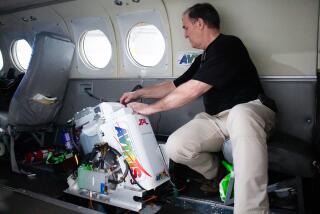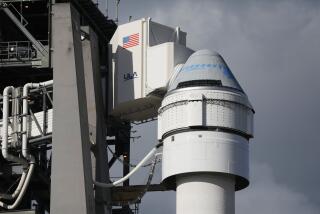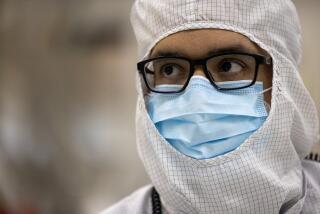Shuttle Science Mission Readied With Eye on Skies
- Share via
KENNEDY SPACE CENTER, Fla. — With a wary eye on the weather, launch crews Friday made ready for the United States’ 50th space shuttle flight, a U.S.-Japanese collaboration portrayed as a significant prelude to NASA’s space station Freedom.
Barring a technical snag, officials hope to send the shuttle Endeavour and its crew of seven on their way to orbit at 7:23 a.m. PDT today, getting away ahead of a cold front bringing rain and thunderstorms from the north.
The seven-day mission will be devoted to 24-hour-a-day operation of a space laboratory shoehorned into Endeavour’s cargo bay and loaded with 44 scientific experiments, 34 of them belonging to the National Space Development Agency of Japan.
For its partnership role, including the participation of the first Japanese-born astronaut, Japan is paying the National Aeronautics and Space Administration about $40 million.
Japanese chemist Mamoru Mohri, 44, is a payload specialist. Other crew members for Endeavour’s second flight are mission commander Robert L. (Hoot) Gibson, a Navy captain making his fourth shuttle flight; shuttle pilot Curtis L. Brown, an Air Force major; mission payload commander Mark Lee; mission specialist Jan Davis, and science mission specialist Mae Jemison.
Jemison, 35, a physician, former Peace Corps medical officer in West Africa and one-time intern at the Los Angeles County/USC Medical Center, is the first African-American woman to fly in space.
Lee and Davis are the first married couple to make a space flight together. They wed after their assignment to the Endeavour crew.
Flight preparations inside the laboratory, dubbed Spacelab J, were completed Friday, and launch crew members worked through the afternoon to finish stowing equipment in the orbiter’s crew compartment.
Experiments secured in cabinets lining the lab’s walls are divided about evenly between material science investigations and biological experiments continuing the study of microgravity’s effects on living things. Subjects for the gravity tests include Japanese carp, frog eggs, fruit flies and chicken embryos.
On the middle flight deck, technicians loaded a tightly closed container of African hornets for a study being conducted by Israeli scientists on the ability to build combs in microgravity.
Today’s launch opportunity extends nearly four hours, from 7:23 a.m. PDT until 11:17 a.m., but weather forecasters said conditions are apt to deteriorate as an unstable storm system moves in from the north.
Vice President Dan Quayle, who heads the National Space Council, planned to arrive in time to witness the launch and speak to members of the launch crew in Kennedy Space Center’s firing room.
In the spacelab, connected by a tunnel to the mid-deck of the Endeavour crew compartment, astronauts will work in a shirt-sleeve environment. Their activities will be coordinated by an operations control center at Marshall Space Flight Center in Alabama, while the shuttle itself is monitored by Mission Control at the Johnson Space Center in Houston.
NASA officials hailed the first phase of their cooperation with the Japanese as a success even as Endeavour sat on the pad. Four years of preparation leading to launch, they said, had already provided experience that will prove useful when the planned space station Freedom is in operation.
The controversial orbiting station, expected to cost $30 billion or more over the rest of this decade, is, by NASA’s current schedule, to be permanently manned by the turn of the century. A Japanese experiment module is to be delivered to the station and attached by the shuttle astronauts in 1998.
The Mission at a Glance
Mission: Endeavour is scheduled for a weeklong science and research mission.
Launch: 7:23 a.m. PDT today.
Weather: Forecasts predicted a 70% chance of favorable weather conditions for liftoff.
Special arrangements: This 25th shuttle flight since Challenger was chartered by the National Space Development Agency of Japan. There is a $1-billion laboratory in Endeavour’s cargo bay.
Crew: Among the seven-member crew are the first professional Japanese astronaut, the first black female astronaut and the first married couple to fly in space.
Experiments: 44 experiments are scheduled in physics, biology and medicine to study alloys, an intravenous fluid pump for first aid in space, and exposure to weightlessness among animals. Four speckled frogs and two foot-long orange-and-white carp, 30 chicken eggs, thousands of fruit flies and hundreds of hornets are on the flight.
More to Read
Sign up for Essential California
The most important California stories and recommendations in your inbox every morning.
You may occasionally receive promotional content from the Los Angeles Times.










